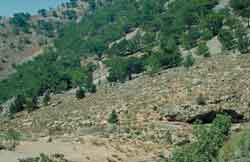Crete in the Graeco-Roman period
 SW of Old Ag. Roumeli. July 1989. © Sphakia Survey |
After the fall of the palace system on Crete, settlements became smaller, less complex, and sometimes located in very defensive locations (e.g. at Ag. Roumeli hidden from the mouth of the Samaria Gorge).
This period, the so-called 'Dark Ages' (tenth to ninth centuries BC), was an unstable and fragile society, vulnerable to attacks from outside. From the eighth century onwards Crete is marked by a large number of independent urban communities (poleis): the traditional description of the island in Homer is 'Crete of a hundred cities'. Some of the major poleis were Kydonia (modern Khania), Knossos, Gortyn, and Hierapytna; in Unit 3 we will look in some detail at one of these sites, Gortyn, looking closely at its Roman context.
 Gortyn: view of law code inscribed on rear wall of Odeion (1982) © Simon Price |
The island flourished greatly in the Geometric period (eighth to mid seventh centuries BC) and Archaic period (mid seventh to sixth centuries BC). There was extensive contact with and borrowings from the east; the Greek alphabet (adapted from the Phoenician alphabet) came into use in the eighth century BC.
However, by the Classical period (fifth to fourth centuries BC) Crete had become rather a backwater.
Poleis fought and made alliances with each other, but the island as a whole remained largely independent of external powers (whether the fifth-century Athenian empire, or the kingdoms that succeeded Alexander the Great in the Hellenistic period, roughly 300-0 BC). Rome, however, conquered the island in 67 BC, administering it jointly with Cyrene (modern Libya) to the south. Roman rule of Crete lasted for the next 900 hundred years. During this period, the capital of the Roman empire moved from Rome to Byzantium (modern Istanbul) in the fourth century (the fourth to seventh centuries AD are known as the Late Roman period).
 Gortyn: church of Agios Titos (1982) © Lucia Nixon |
During the Roman period Crete remained a predominantly Greek area (as did the rest of the eastern Mediterranean). The language was Greek (Latin was used only by Roman officials), and the island's cultural heritage was focused on the classical past. Economically the island formed part of a Mediterranean economy: goods from Italy and the eastern Aegean were imported to Crete, and wine was exported to Italy.
Christianity spread to Crete during this period: it traced its roots to the travels of SS Paul and Titus, but saw its real growth in the fifth and sixth centuries.
Like other aspects of Cretan culture, it was Greek in its language and organisation.